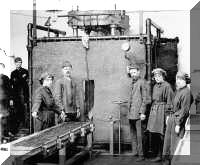|
Production Acids
Sulphuric acid was made from the burning of iron
pyrites (iron sulphide), and the sulphur dioxide produced converted to
sulphur trioxide by passing it over a platinised asbestos catalyst and
absorbing it into dilute sulphuric acid. A plant for the
reconcentration of used acid was built during World War II.
Nitric acid was produced by the action of sulphuric
acid on saltpetre (sodium nitrate) in 12 cast iron stills. Nitre
cake was a by-product of the process and was sold to Harpic Ltd for use
in the manufacture of their famous household cleanser.
Nitroglycerine (NG)
The manufacture of NG was an extremely hazardous
process where mixed acids and glycerine were combined to form a
colourless liquid. Initially, the NG was made in batches of around
1½ tons. Following a serious explosion in
1931 when 10 workers were killed, a newer, continuous process (Schmid)
was adopted.
Guncotton (GC) / Nitrocellulose (NC)
GC and NC were produced by the action of mixed acids
on cotton waste or paper.
Cordite
 Cordite
was made by mixing guncotton or nitrocellulose with nitroglycerine.
The resulting solid was rolled and cut to fit hydraulic presses.
The extruded cordite would then be cut to the required length.
During World War I, Cordite MD was manufactured and consisted of 30% NG,
65% GC and 5% mineral jelly. Acetone was added during the mixing
processed to aid incorporation. Cordite
was made by mixing guncotton or nitrocellulose with nitroglycerine.
The resulting solid was rolled and cut to fit hydraulic presses.
The extruded cordite would then be cut to the required length.
During World War I, Cordite MD was manufactured and consisted of 30% NG,
65% GC and 5% mineral jelly. Acetone was added during the mixing
processed to aid incorporation.
Cordite SC contained a larger percentage of NG and
carbamite replaced the mineral jelly. Acetone was no longer
required for making cordite SC.
Flashless cordite (NF) used a large proportion of
picrite, but required the use of acetone for mixing. Picrite was a
white crystalline powder made by the action of mixed acids on guanidine
nitrate, which itself was made from the fusion of ammonium nitrate and
dicyandiamide. The addition of picrite was to reduce muzzle flash
and barrel wear.
Tetryl
Tetryl was unconnected with cordite production but
utilised the available supply of mixed acids, blending them with
dimethylaniline to form a yellow, crystalline explosive used as an
intermediary between detonator and explosive charge in bombs and shells.
|
![]()
![]()
![]()
![]()
![]()
![]()